
Aizoaceae
Encyclopedia
The Family Aizoaceae or Ficoidaceae (fig-marigold family or ice plant family) is a taxon of dicotyledon
ous flowering plants containing 135 genera and about 1900 species. They are commonly known as stone plants or carpet weeds. Species that resemble stones or pebbles are sometimes called mesembs. Several species are known as ice plant
.
of 2003 (unchanged from the APG system
of 1998) also recognises the family, and assigns it to the order Caryophyllales
in the clade core eudicots. The APG II system also classes the former families Mesembryanthemaceae Fenzl (1836) , Sesuviaceae Horan. (1834) and Tetragoniaceae Link (1831) under the family Aizoaceae.
Most species (96 %, 1782 species in 132 genera) in this family are endemic to arid or semi-arid parts of southern Africa
, but a few are from Australia
and the Central Pacific. Most of these species are succulents and belong to the subfamilies Mesembryanthemoideae and Ruschioideae and are loosely termed mesems or mesembs.
Most fig-marigolds are herbaceous
, rarely somewhat woody, with stems
growing either erect or prostrate. Leaves
are simple, opposite or alternate, and more or less succulent with entire (or rarely toothed) margins. Flower
s are perfect in most species (but unisexual in some), actinomorphic, and appear singularly or in few-flowered cymes developing from the leaf axils. Sepal
s are typically 5 (3-8) and more or less connate (fused) below. True petal
s are absent. However, some species have numerous linear petals derived from staminoides. The fruit
is a capsule
with one to numerous seed
s per cell.
A few species (especially Carpobrotus edulis, commonly called Ice Plant
) have been widely introduced
and become invasive.
Carpobrotus edulis was introduced
to California to stabilize soil along railroad tracks.
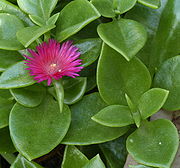
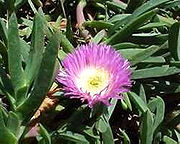
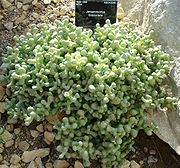
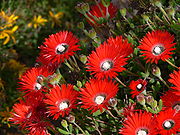
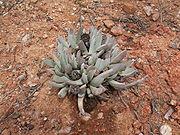
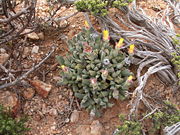
Dicotyledon
The dicotyledons, also known as dicots, are a group of flowering plants whose seed typically has two embryonic leaves or cotyledons. There are around 199,350 species within this group...
ous flowering plants containing 135 genera and about 1900 species. They are commonly known as stone plants or carpet weeds. Species that resemble stones or pebbles are sometimes called mesembs. Several species are known as ice plant
Ice plant
- Plant common names :* Aizoaceae, the ice plant family* Carpobrotus chilensis* Carpobrotus edulis* Conicosia, narrow-leafed ice plants* Delosperma cooperi, Cooper's ice plant* Delosperma bosseranum...
.
Description
The family is widely recognised by taxonomists, although once it went by the botanical name "Ficoideae", now disallowed. The APG II systemAPG II system
The APG II system of plant classification is the second, now obsolete, version of a modern, mostly molecular-based, system of plant taxonomy that was published in April 2003 by the Angiosperm Phylogeny Group. It was a revision of the first APG system, published in 1998, and was superseded in 2009...
of 2003 (unchanged from the APG system
APG system
The APG system of plant classification is the first, now obsolete, version of a modern, mostly molecular-based, system of plant taxonomy that was published in 1998 by the Angiosperm Phylogeny Group. It was superseded in 2003 by a revision, the APG II system, and then in 2009 by a further...
of 1998) also recognises the family, and assigns it to the order Caryophyllales
Caryophyllales
Caryophyllales is an order of flowering plants that includes the cacti, carnations, amaranths, ice plants, and many carnivorous plants. Many members are succulent, having fleshy stems or leaves.-Description:...
in the clade core eudicots. The APG II system also classes the former families Mesembryanthemaceae Fenzl (1836) , Sesuviaceae Horan. (1834) and Tetragoniaceae Link (1831) under the family Aizoaceae.
Most species (96 %, 1782 species in 132 genera) in this family are endemic to arid or semi-arid parts of southern Africa
Africa
Africa is the world's second largest and second most populous continent, after Asia. At about 30.2 million km² including adjacent islands, it covers 6% of the Earth's total surface area and 20.4% of the total land area...
, but a few are from Australia
Australia
Australia , officially the Commonwealth of Australia, is a country in the Southern Hemisphere comprising the mainland of the Australian continent, the island of Tasmania, and numerous smaller islands in the Indian and Pacific Oceans. It is the world's sixth-largest country by total area...
and the Central Pacific. Most of these species are succulents and belong to the subfamilies Mesembryanthemoideae and Ruschioideae and are loosely termed mesems or mesembs.
Most fig-marigolds are herbaceous
Herbaceous
A herbaceous plant is a plant that has leaves and stems that die down at the end of the growing season to the soil level. They have no persistent woody stem above ground...
, rarely somewhat woody, with stems
Plant stem
A stem is one of two main structural axes of a vascular plant. The stem is normally divided into nodes and internodes, the nodes hold buds which grow into one or more leaves, inflorescence , conifer cones, roots, other stems etc. The internodes distance one node from another...
growing either erect or prostrate. Leaves
Leaf
A leaf is an organ of a vascular plant, as defined in botanical terms, and in particular in plant morphology. Foliage is a mass noun that refers to leaves as a feature of plants....
are simple, opposite or alternate, and more or less succulent with entire (or rarely toothed) margins. Flower
Flower
A flower, sometimes known as a bloom or blossom, is the reproductive structure found in flowering plants . The biological function of a flower is to effect reproduction, usually by providing a mechanism for the union of sperm with eggs...
s are perfect in most species (but unisexual in some), actinomorphic, and appear singularly or in few-flowered cymes developing from the leaf axils. Sepal
Sepal
A sepal is a part of the flower of angiosperms . Collectively the sepals form the calyx, which is the outermost whorl of parts that form a flower. Usually green, sepals have the typical function of protecting the petals when the flower is in bud...
s are typically 5 (3-8) and more or less connate (fused) below. True petal
Petal
Petals are modified leaves that surround the reproductive parts of flowers. They often are brightly colored or unusually shaped to attract pollinators. Together, all of the petals of a flower are called a corolla. Petals are usually accompanied by another set of special leaves called sepals lying...
s are absent. However, some species have numerous linear petals derived from staminoides. The fruit
Fruit
In broad terms, a fruit is a structure of a plant that contains its seeds.The term has different meanings dependent on context. In non-technical usage, such as food preparation, fruit normally means the fleshy seed-associated structures of certain plants that are sweet and edible in the raw state,...
is a capsule
Capsule (fruit)
In botany a capsule is a type of simple, dry fruit produced by many species of flowering plants. A capsule is a structure composed of two or more carpels that in most cases is dehiscent, i.e. at maturity, it splits apart to release the seeds within. A few capsules are indehiscent, for example...
with one to numerous seed
Seed
A seed is a small embryonic plant enclosed in a covering called the seed coat, usually with some stored food. It is the product of the ripened ovule of gymnosperm and angiosperm plants which occurs after fertilization and some growth within the mother plant...
s per cell.
A few species (especially Carpobrotus edulis, commonly called Ice Plant
Ice Plant
Carpobrotus edulis is native to South Africa. It is also known as ice plant, Highway Ice Plant, Pigface or Hottentot Fig and in South Africa as the Sour Fig , on account of its edible fruit....
) have been widely introduced
Introduced species
An introduced species — or neozoon, alien, exotic, non-indigenous, or non-native species, or simply an introduction, is a species living outside its indigenous or native distributional range, and has arrived in an ecosystem or plant community by human activity, either deliberate or accidental...
and become invasive.
Uses
Several Aizoaceae are edible, including:- Carpobrotus edulis and Mesembryanthemum crystallinumMesembryanthemum crystallinumMesembryanthemum crystallinum is a prostrate succulent plant that is native to Africa, Western Asia and Europe. The plant is covered with large, glistening bladder cells, reflected in its common names of Common Ice Plant, Crystalline Iceplant or Iceplant.-Uses:Its leaves are edible, as with some...
have edible leaves, and are both commonly called Ice plantIce plant- Plant common names :* Aizoaceae, the ice plant family* Carpobrotus chilensis* Carpobrotus edulis* Conicosia, narrow-leafed ice plants* Delosperma cooperi, Cooper's ice plant* Delosperma bosseranum... - A species known as New Zealand spinach (Tetragonia tetragonioides) is grown as a garden plant in somewhat dry climates and used as an alternative to spinachSpinachSpinach is an edible flowering plant in the family of Amaranthaceae. It is native to central and southwestern Asia. It is an annual plant , which grows to a height of up to 30 cm. Spinach may survive over winter in temperate regions...
in upscale saladSaladSalad is any of a wide variety of dishes, including vegetable salads; salads of pasta, legumes, eggs, or grains; mixed salads incorporating meat, poultry, or seafood; and fruit salads. They may include a mixture of cold and hot, often including raw vegetables or fruits.Green salads include leaf...
s.
Carpobrotus edulis was introduced
Introduced species
An introduced species — or neozoon, alien, exotic, non-indigenous, or non-native species, or simply an introduction, is a species living outside its indigenous or native distributional range, and has arrived in an ecosystem or plant community by human activity, either deliberate or accidental...
to California to stabilize soil along railroad tracks.
Genera






Subfamily Aizooideae
- Acrosanthes Eckl. & Zeyh.
- AizoanthemumAizoanthemumAizoanthemum is a small genus of plant in the family Aizoaceae, native to Namibia and Angola. It has only 5 species. Before being given their own genus, these species were considered a subgenus of Aizoon....
Dinter ex Friedrich - AizoonAizoonAizoon is a genus of flowering plants in the iceplant family, Aizoaceae.-Species:*Aizoon asbestinum*Aizoon burchellii*Aizoon camforosma*Aizoon canariense*Aizoon giessii*Aizoon glinoides...
L. - GaleniaGaleniaGalenia is a genus of low growing perennial herbs in the family Aizoaceae. The genus is endemic to southern Africa.Species include::*Galenia acutifolia Adamson*Galenia affinis Sond. *Galenia africana L....
L. - Gunniopsis Pax
- Plinthus Fenzl
- TetragoniaTetragoniaTetragonia is a genus of 50-60 species of flowering plants in the family Aizoaceae, native to temperate and subtropical regions mostly of the Southern Hemisphere, in New Zealand, Australia, southern Africa and South America...
L.
Subfamily Mesembryanthemoideae
|
|
Subfamily Ruschioideae
Tribe Apatesieae
Tribe Dorotheantheae
Tribe Ruschiae
|
Disphyma Disphyma is a monotypic genus of succulent shrubs. Commonly known as Round-leaved Pigface, it occurs in South Africa, Australia and New Zealand. Its sole species, Disphyma crassifolium, is divided into two subspecies, D. crassifolium subsp. crassifolium and D. crassifolium subsp... N.E.Br Drosanthemum Drosanthemum is a genus of succulent plants in the ice plant family native to southern Africa. They are known commonly as dewflowers or vygies... Schwantes Faucaria Faucaria is a genus of around 33 species of succulent subtropical plants of the family Aizoaceae.The name comes from the Latin word "fauces" because of the appearance of leaves.... Schwantes Fenestraria Fenestraria is a monotypic genus of succulent plants in the family Aizoaceae. The species is also called babies toes or window plant.... N.E.Br Frithia Frithia is a genus of plant in family Aizoaceae. It contains the following species:* Frithia pulchra N.E.Br.* Frithia humilis Burgoyne.... N.E.Br Gibbaeum Gibbaeum is a genus of about 21 species of succulent plants of the family Aizoaceae.The name "Gibbaeum" comes from the Latin "gibbosus" They come from South Africa -Description:... Haw. ex N.E.Br Glottiphyllum Glottiphyllum is a genus of about 57 species of succulent subtropical plants of the family Aizoaceae.The name comes from the ancient Greek "γλωττίς" and "φύλλον" .... Haw. ex N.E.Br Jensenobotrya Jensenobotrya lossowiana is the only species of genus Jensenobotrya, in the Aizoaceae family. It is a succulent plant endemic to Namibia. Its natural habitat is rocky areas. It grows at Dolphin Head in Spencer Bay where it obtains moisture from the saline mists... A.G.J.Herre Jordaaniella Jordaaniella is a genus of plant in family Aizoaceae. The plants of this genus are indigenous to southern Africa.Species include :* Jordaaniella anemoniflora , N.E.Br... H.E.K.Hartmann Juttadinteria Juttadinteria is a genus of plant in family Aizoaceae.Species include:* Juttadinteria deserticola, Schwantes* Juttadinteria kovisimontana, Schwantes* Juttadinteria simpsonii, Schwantes... Schwantes Khadia Khadia is a genus of plant in family Aizoaceae. It contains the following species :* Khadia acutipetala* Khadia alticola* Khadia beswickii, N.E.Br.* Khadia borealis* Khadia carolinensis... N.E.Br Lampranthus Lampranthus is a genus of plants in the family Aizoaceae. All are succulent plants.One of the species in this genus is L. roseus, the mini ice plant.-Reproduction:... N.E.Br Lithops Lithops is a genus of succulent plants in the ice plant family, Aizoaceae. Members of the genus are native to southern Africa. The name is derived from the Ancient Greek words λίθος , meaning "stone," and ὄψ , meaning "face," referring to the stone-like appearance of the plants... N.E.Br Machairophyllum Machairophyllum is a genus of plants in the family Aizoaceae.-Selected species:Machairophyllum acuminatum L.BolusMachairophyllum albidum SchwantesMachairophyllum baxteri L.BolusMachairophyllum bijlii L.Bolus... Schwantes Malephora Malephora is a genus of succulent plants in the ice plant family. There are 13 to 17 species in the genus, many of which are known commonly as mesembs. They are native to Africa.... N.E.Br |
Pleiospilos Pleiospilos is a genus of South African succulent plants that belong to the Aizoaceae family. The name is derived from the Greek “pleios” and “spìlos”... N.E.Br Psammophora Psammophora is a genus of plant in family Aizoaceae. It contains the following species :* Psammophora nissenii, Dinter & Schwantes* Psammophora saxicola, H.E.K.Hartmann... Dinter & Schwantes Ruschia Ruschia is a genus of plant in family Aizoaceae.Species include:* Ruschia namusmontana, Friedrich... Schwantes Ruschianthus Ruschianthus falcatus is a species of plant in the Aizoaceae family. It is endemic to Namibia. Its natural habitat is rocky areas. It is the only species in the monotypic genus Ruschianthus.-External links:... L.Bolus Schwantesia Schwantesia is a genus of plant in the family Aizoaceae. It is named in honor of the german botanist and archaeologist Gustav Schwantes .Species include:* Schwantesia constanceae, N.Zimm.... Dinter Titanopsis Titanopsis is a genus of about 10 species of succulent plants of the family Aizoaceae.The name "Titanopsis" comes from the ancient greek "titanos" et "opsis" They come from South Africa... Schwantes Trichodiadema Trichodiadema is a genus of succulent plants of the family Aizoaceae.The name "Trichodiadema" comes from the ancient greek "thrix" and "diadema" They come from Cape Province in South Africa.- Description :... Schwantes |
Subfamily Sesuvioideae
- Cypselea Turpin
- SesuviumSesuviumSesuvium is a genus of flowering plants in the ice plant family, Aizoaceae. The roughly eight species it contains are commonly known as sea-purslanes.-Selected species:* Sesuvium crithmoides Welw. – Tropical Sea-purslane...
L. - TrianthemaTrianthemaTrianthema is a genus of flowering plants in the ice plant family, Aizoaceae. Members of the genus are annuals or perennials generally characterized by fleshy, opposite, unequal, smooth-margined leaves, a prostrate growth form, flowers with five perianth segments subtended by a pair of bracts, and...
L. - Tribulocarpus S.Moore
- Zaleya Burm.f.
Incertae sedis
- Corbichonia
- Gisekia
- Herreanthus
- Limeum
- Ophthalmophyllum
- Saphesia
External links
- Aizoaceae in L. Watson and M.J. Dallwitz (1992 onwards). The families of flowering plants
- NCBI Taxonomy Browser
- P. Chesselet (2004 onwards). Interactive Mesembs2
- Plants of southern Africa (2005 onwards). SANBI
- Aizoaceae of South Africa
- Family Aizoaceae Flowers in Israel

